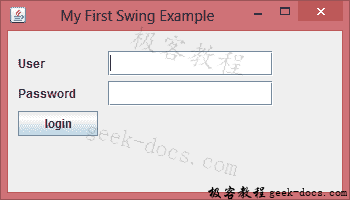Swing 是 Java 基础类(JFC)的一部分,JFC 的其他部分是 java2D 和抽象 window 工具包(AWT)。 AWT,Swing 和 Java 2D 用于在 java 中构建图形用户界面(GUI)。在本教程中,我们将主要讨论用于在 AWT 顶部构建 GUI 的 Swing API,与 AWT 相比,它更轻量级。
一个简单的例子
在下面的示例中,我们将使用您在本教程中到目前为止尚未学习的几个 swing 组件。我们将在即将到来的摇摆教程中详细讨论每一个和所有内容。
下面的 swing 程序会创建一个登录界面。
import javax.swing.JButton;
import javax.swing.JFrame;
import javax.swing.JLabel;
import javax.swing.JPanel;
import javax.swing.JPasswordField;
import javax.swing.JTextField;
public class SwingFirstExample {
public static void main(String[] args) {
// Creating instance of JFrame
JFrame frame = new JFrame("My First Swing Example");
// Setting the width and height of frame
frame.setSize(350, 200);
frame.setDefaultCloseOperation(JFrame.EXIT_ON_CLOSE);
/* Creating panel. This is same as a div tag in HTML
* We can create several panels and add them to specific
* positions in a JFrame. Inside panels we can add text
* fields, buttons and other components.
*/
JPanel panel = new JPanel();
// adding panel to frame
frame.add(panel);
/* calling user defined method for adding components
* to the panel.
*/
placeComponents(panel);
// Setting the frame visibility to true
frame.setVisible(true);
}
private static void placeComponents(JPanel panel) {
/* We will discuss about layouts in the later sections
* of this tutorial. For now we are setting the layout
* to null
*/
panel.setLayout(null);
// Creating JLabel
JLabel userLabel = new JLabel("User");
/* This method specifies the location and size
* of component. setBounds(x, y, width, height)
* here (x,y) are cordinates from the top left
* corner and remaining two arguments are the width
* and height of the component.
*/
userLabel.setBounds(10,20,80,25);
panel.add(userLabel);
/* Creating text field where user is supposed to
* enter user name.
*/
JTextField userText = new JTextField(20);
userText.setBounds(100,20,165,25);
panel.add(userText);
// Same process for password label and text field.
JLabel passwordLabel = new JLabel("Password");
passwordLabel.setBounds(10,50,80,25);
panel.add(passwordLabel);
/*This is similar to text field but it hides the user
* entered data and displays dots instead to protect
* the password like we normally see on login screens.
*/
JPasswordField passwordText = new JPasswordField(20);
passwordText.setBounds(100,50,165,25);
panel.add(passwordText);
// Creating login button
JButton loginButton = new JButton("login");
loginButton.setBounds(10, 80, 80, 25);
panel.add(loginButton);
}
}
输出:

在上面的例子中,我们使用了几个组件。我们先讨论一下它们,然后我们将在下一个教程中详细讨论它们。
JFrame – 帧是JFrame的一个实例。框架是一个窗口,可以有标题,边框,菜单,按钮,文本字段和其他几个组件。 Swing 应用必须有一个框架才能添加组件。
JPanel – 面板是JPanel的一个实例。一个框架可以有多个面板,每个面板可以有几个组件。你也可以称它们为 Frame 的一部分。面板可用于对组件进行分组并将它们放置在框架中的适当位置。
JLabel – 标签是JLabel类的一个实例。标签是不可选择的文本和图像。如果要在框架上显示字符串或图像,可以使用标签。在上面的例子中,我们想要在文本字段之前显示文本"User"和"Password",我们通过创建标签并将其添加到适当的位置来实现此目的。
JTextField – 用于捕获用户输入,这些是用户输入数据的文本框。
JPasswordField – 与文本字段类似,但输入的数据被隐藏并在 GUI 上显示为点。
JButton – 一个按钮是JButton类的一个实例。在上面的例子中,我们有一个“登录”按钮。
 极客教程
极客教程